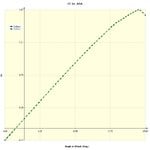Pretty much posting this because I don't know where I should be looking that I haven't already. I'm looking for some very specific data about the P-40E regarding it's wing design, specifically, the determination of it's coefficient of lift (CLMax). The only data on this that I have been able to find that contains information that can be used to determine this is a RAE Boscome Down test. Unfortunately, the derived lift coefficient from these tests is unusually high, to the point that it casts doubt about the validity of the data collected. What I want - really, really want - is a Curtiss-Wright document that provides similar data, either collected during initial flight testing, or at some later date. A document that just lists what the engineers were trying to achieve with regards to this would also be great.
I've actually tried contacting Curtiss-Wright and got nowhere (I'm wouldn't be surprised if some intern read my inquiry and didn't have any idea what to do with it). If someone had contact information where I could take my questions in a more productive area that would be also great.
I have not attempted to get NASM data simply because all I have is vague descriptions on what is in certain boxes and no guarantee that it would contain anything useful. If I lived close I'd just drive over there and copy the whole damn thing but that's not an option. I'm also interested in any other data about the plane that could be useful in similar areas, such as the design critical AoA or perhaps time to reach max speed from X starting speed (computation of acceleration and possibly overall drag).
Thanks for any light you can shed on this. Old records can be hard to find, but this hard is very frustrating.
I've actually tried contacting Curtiss-Wright and got nowhere (I'm wouldn't be surprised if some intern read my inquiry and didn't have any idea what to do with it). If someone had contact information where I could take my questions in a more productive area that would be also great.
I have not attempted to get NASM data simply because all I have is vague descriptions on what is in certain boxes and no guarantee that it would contain anything useful. If I lived close I'd just drive over there and copy the whole damn thing but that's not an option. I'm also interested in any other data about the plane that could be useful in similar areas, such as the design critical AoA or perhaps time to reach max speed from X starting speed (computation of acceleration and possibly overall drag).
Thanks for any light you can shed on this. Old records can be hard to find, but this hard is very frustrating.

